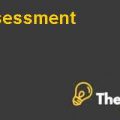In this report, Royal Bank of Canada is selected for the analysis of risk management and risk exposure in Canadian financial institutions. In part 1 of the report,the risks that the bank is exposed to in the year 2007 and then in the year 2017 have been discussed, to analyze the change in risks in 10 year time and the approach that bank uses to hedge its risks. Secondly, the major events that took place for the bank in the 10-year time span from 2007 to 2017 have been discussed. In part 2, an analysis of liquidity risk is done along with the relevant information on the liquidity ratios. In addition to this, the bank’s approach to the management of liquidity is also discussed. In part 3, the sources of income are analyzed and an analysis of profitability is done by taking into account the profitability and efficiency ratios. In part 4, the focus is on the credit risk management, impaired loans, mortgages, and other non-performing loans. In part 5, the capital structure of the bank is analyzed for the whole time span. Lastly, in part 6, for the analysis of market performance of the bank, its return to shareholders is analyzed.
Part I: 10 Years in the Life of Canadian Bank
Major Risks in 2007
The two major risks that the company identified important as of 2007 are listed and discussed below.
- Credit Risk
- Market Risk
Credit Risk
Credit risk is when the counter-party is unable to pay off its obligations. It can be direct or indirect both, which means that the bank is exposed to credit risk from issues, policyholders, debtor, guarantor, and reinsurer. As the bank offers a wide variety of credit services and products to customers in Canada and in numerous countries around the globe as well, which includes, mortgages, loans, letter of credits, credit cards, short-term investments, and insurance activities, it is highly exposed to this type of risk by the counter-party.
Royal Bank Of Canada Harvard Case Solution & Analysis
The major business of the bank is associated with providing credit services and products to the customers and is also a major driver of the overall performance of the bank. Thus, if the company fails to manage this risk, it is likely to have a drastic effect on the overall performance of the bank. This is the reason why credit risk is considered as most important by the bank. (Royal Bank of Canada Annual Report 2007, 2007)
Market Risk
Another important risk as mentioned by the Royal Bank of Canada in its report of 2007 is the market risk. It is defined as the loss incurred in result of changes in factors affecting market conditions.
There are a number of factors that can change an overall situation of the market. This includes, the pertaining interest rates, prices of equity and commodities, spreads, and foreign exchange rates.
The Royal Bank of Canada is exposed to market risk as it is involved in trading activities and management activities regarding asset and liability. The level of risk that the bank is exposed to is obviously dependent upon the above mentioned factors, but other than this, the expectation of the market yield and future prices also determines the market risk...............
This is just a sample partical work. Please place the order on the website to get your own originally done case solution.










